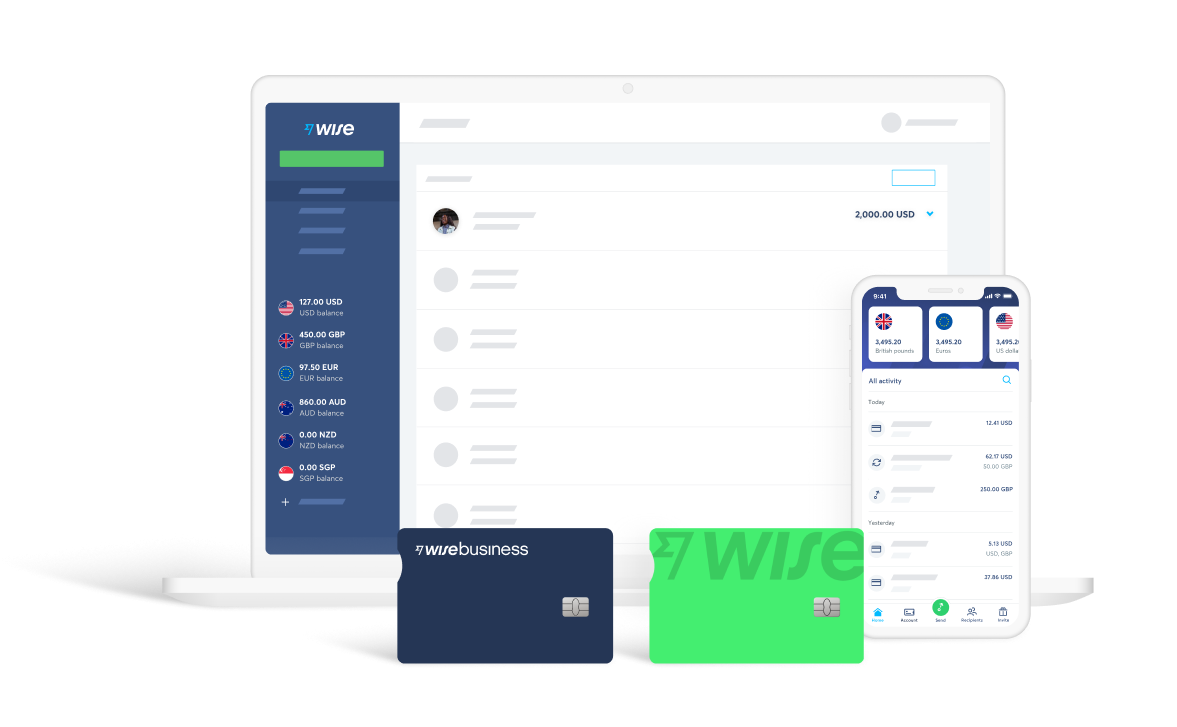
Fiverr vs Upwork - which freelancing site is better?
Freelance marketplace sites like Upwork and Fiverr connect talented professionals around the world with companies looking to hire extra resource for their business. As more and more of life - and work - moves online, freelance work is becoming increasingly common, offering flexible opportunities for both individuals and the businesses that employ them.
If you’re thinking of starting to use a marketplace site to find freelance work, or to hire top talent for your business, this Upwork vs Fiverr review is for you. We’ll walk through how both platforms work, who they might suit, and what it’ll cost you to use them.
And to help you keep more of your money when you get paid through freelance marketplace sites, we’ll also introduce Wise. Open a Wise account to get paid in USD and a selection of up to 10 different currencies - and convert to the currencies you need with low fees and the Google exchange rate.
| Table of contents |
|---|
What is Upwork?
Upwork¹ has been around for over 20 years - although it was originally known as Elance and then o-Desk. Upwork lets freelancers across a broad range of industry verticals post project proposals, and apply to gigs which have been advertised by prospective employers. Companies looking to onboard new team members can also browse freelancers listed in Upwork, or specifically post a project and allow freelancers to apply to it.
Upwork splits freelancers by industry and role type, and covers:
- Development and IT
- Design and creative
- Sales and Marketing
- Writing and translation
- Admin and customer support
- Finance and accounting
- Engineering and architecture
- HR and training
- Legal
Upwork gets 10,000 new freelancer applications every day. All applications have to be reviewed and approved - which means your application could be turned down if you’ve not got a strong enough profile, or if the skills and services you offer aren’t in demand².
What is Fiverr?
Fiverr³ allows freelancers - called sellers - to create project proposals which are posted online, for clients - known on Fiverr as buyers - to browse and select. If an employer selects your gig, you’ll be able to negotiate the project scope and confirm the fees, before getting started on the work.
Fiverr gigs are listed across the following segments:
- Graphics and design
- Video and animation
- Writing and translation
- AI services
- Digital marketing
- Music and audio
- Programming and tech
- Business
- Lifestyle
Fiverr projects can be priced at anything from 5 USD to 995 USD, and you can offer up to 3 different project tiers covering different levels of service, with their own corresponding fees.
Please see the Terms of Use for your region or visit Wise fees & pricing for the most up-to-date information on pricing and fees
Upwork vs Fiverr - pros and cons
Before we get into the details about how Upwork and Fiverr work - and how much they’ll charge you - let’s take a look at a quick overview of some of the pros and cons of each platform.
| Pros | Cons | |
|---|---|---|
| Fiverr |
|
|
| Upwork |
|
|
How to use Upwork as a freelancer
Let’s take a look at how to get started on Upwork as a freelancer. There’s no fee to set up an Upwork account, but you’ll pay fees to Upwork as soon as you start to take on paid employment through the site.
Wondering: how much does Upwork take from freelancers? Don’t worry, we’ll cover these costs a little later, plus a word on how you can avoid Upwork’s currency conversion fees, and keep more of your money for yourself in the end.
To set up an account with Upwork you’ll need to first create a profile. You can add your work history, skills and experience, as well as a photo or even a video introduction. The strongest profiles are client focused and eye catching - and in a competitive marketplace, it’s certainly worth investing some time into creating a profile which stands out.
Once you have an approved Upwork account, you can find work in a couple of different ways:
- Search posted jobs on Talent Marketplace - if you see something that appeals you can then reach out to the employer to discuss working together
- Create projects on Project catalog - here you can upload details of prescoped work, including your fees, for employers to browse and connect with you
- Work with an Upwork recruiter - if your work is really in demand, you could also receive support from Upwork staff who can help match you with employers looking for your expertise
Once you’ve found the right project for you, you’ll be able to negotiate the details with the employer, and sign a contract. Work could be hourly paid, or based on project delivery milestones. In either case, the employer will make payment to Upwork, and the money will be released to you weekly for hourly paid gigs, upon successful completion of the project, or at the stage you reach agreed milestones.
Upwork charges a fee for the services it providers. The exact amount you pay will vary based on how frequently you work with the same client, from 5% to 20% of your total earnings.
How to use Fiverr as a freelancer
While Fiverr and Upwork are both marketplaces connecting freelancers with employers, they do work in different ways. Fiverr doesn’t have the option for employers to post work for freelancers to browse. Instead, as a freelancer you’ll create gigs - project outlines - which employers can review.
That means it’s more suited to one off projects rather than freelancers who want to create an ongoing relationship with a client, to work together regularly or on an hourly paid basis.
To use Fiverr you’ll need to first create an account, and set up your profile. You can then start to add project scopes. It’s handy to know that this initial stage must be completed on a desktop computer⁴ - you can’t get started in the Fiverr app. However, once your account is up and running you’ll be able to review and manage your account in the app.
Fiverr offers the option to add up to 3 different gig tiers, so you can effectively upsell and create differing levels of service for customers. You can also add extra options, such as paying an extra fee for faster delivery, to boost your sales and give the customer a better experience.
So, how much does Fiverr charge from the seller (the freelancer)? Unlike Upwork, Fiverr has a flat pricing model which means you’ll pay 20% of your earnings, at a flat rate, to the platform.
Getting paid from Upwork or Fiverr
One of the major advantages of using a freelance platform like Upwork or Fiverr is that the platform offers some protection and support when billing clients. What this means is that the employer will pay the platform, and the platform will release the funds - minus the platform’s own fees - either on a weekly basis for hourly billed work, or upon completion of agreed milestones.
Upwork prices all projects in USD⁵, to appeal to a global marketplace. However, both Upwork and Fiverr do offer the option of withdrawing your funds in a different currency if you’d like to. Fiverr supports 6 currencies⁶ for withdrawal, while Upwork has a broad range of supported currencies for payments direct to local bank accounts⁷.
However, there’s one major downside when withdrawing from a freelance platform in a currency other than the one you’ve been paid in - cost. Fees are likely to apply when you withdraw your money - on top of the platform fee you’ve already paid - which can include a service charge and a currency exchange rate markup. This can mean that you end up with far less money than you expected in the end.
Instead of using the Upwork or Fiverr currency conversion service, you could stand to keep more of your earnings if you use a multi-currency account like the Wise Business account, to withdraw your funds in the currency you’re paid in, and then convert to the currency you need with the Google exchange rate and no sneaky hidden fees. More on that next.
Use Wise to avoid Upwork’s or Fiverr’s exchange rate mark-up: receive money in USD and convert it to your local currency with the mid-market exchange rate
If you’re getting paid in USD through Fiverr or Upwork, you could cut your currency conversion costs by using Wise.
Open a Wise account to access local bank details for USD - and a selection of other currencies - to get paid from Upwork or Fiverr with no currency conversion fee. This allows you to receive local USD payments without a receiving fee (except USD wire transfers).

Then once your money is in your Wise account you can hold it as USD, spend it with your linked Wise card, or convert it to any 50+ available currencies you need using the mid-market exchange rate and low, transparent fees, to withdraw back to your local bank account.
Here’s how to sign up for a Wise account:
- Download the Wise app or head to the Wise desktop site
- Click Register
- Create an account by entering your personal and business details
- Get verified - you can upload images of your ID and business documents right from your phone
- Start transacting, or pay a low one time fee to get full feature account access or a Wise card
Pricing/fees: Please see Terms of Use for your region or visit Wise Fees & Pricing for the most up to date pricing and fee information
Fiverr vs Upwork - comparison
So as we’ve seen, Fiverr vs Upwork have a similar aim - connecting freelancers with paying clients - but do work a little bit differently to each other. If you’re still on the fence about which may work best for you, take a look at our quick side by side comparison.
| Feature | Fiverr | Upwork |
|---|---|---|
| Account types | Earn seller levels based on how often you work and the feedback you get from clients | Earn account badges reflecting your job performance |
| Ways to find work | Post a gig - a project - for clients to browse, search and buy | Browse employer adverts, post your own pre-scoped project proposals, or have a recruiter help you connect with employers |
| Fees | 20% service fee paid by the freelancer | Fees are based on your lifetime earnings with a client: 20% of earnings up to $500 10% of earnings from $500.01 to $10,000 5% of earnings above $10,000 |
| Payout methods | Broad selection of payout options including bank transfer, PayPal and Payoneer | Broad selection of payout options including bank transfer, PayPal and Payoneer |
| Payout currencies | 6 supported currencies | Broad selection of supported currencies for local bank deposits |
Conclusion: Is Fiverr or Upwork better?
With more and more of us working online, and getting involved in the gig economy, it’s no surprise that freelance marketplace sites like Fiverr and Upwork are increasingly popular.
Whether Fiverr or Upwork is right for you will ultimately depend on the type of work you do, and how you prefer to connect with clients. If you prefer to browse employer adverts, then Upwork is likely to be the one for you - but Fiverr could suit you if you prefer to post your own packages online with options to build tiered project scopes and offer add on sales. Upwork also has the edge on fees if you’re likely to work frequently with the same client - while Fiverr tends to lean more towards one off project work which you may not repeat.
Given there’s no sign up fee with either platform, the best way to get started may simply be to register with both sites and see which suits your personal preferences best. And don’t forget, of course, to check out Wise as a great way to make sure you’re keeping as much of your freelance earnings as you possibly can, with low cost currency exchange and international payments.
Sources:
- Upwork
- Upwork FAQ
- Fiverr
- Fiverr FAQ
- Upwork - payment currencies
- Fiverr - withdrawing your money
- Upwork - withdrawal currencies
Sources checked on 06/02/2023
*Please see terms of use and product availability for your region or visit Wise fees and pricing for the most up to date pricing and fee information.
This publication is provided for general information purposes and does not constitute legal, tax or other professional advice from Wise Payments Limited or its subsidiaries and its affiliates, and it is not intended as a substitute for obtaining advice from a financial advisor or any other professional.
We make no representations, warranties or guarantees, whether expressed or implied, that the content in the publication is accurate, complete or up to date.


